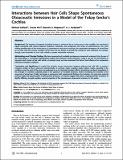Por favor, use este identificador para citar o enlazar a este item:
http://hdl.handle.net/10261/43671COMPARTIR / EXPORTAR:
 SHARE SHARE
 CORE
BASE CORE
BASE
|
|
| Visualizar otros formatos: MARC | Dublin Core | RDF | ORE | MODS | METS | DIDL | DATACITE | |

| Título: | Interactions between Hair Cells Shape Spontaneous Otoacoustic Emissions in a Model of the Tokay Gecko's Cochlea |
Autor: | Gelfand, Michael; Piro, Oreste CSIC ORCID; Magnasco, Marcelo O.; Hudspeth, A. J. | Fecha de publicación: | 15-jun-2010 | Editor: | Public Library of Science | Citación: | PLoS ONE 5(6): e11116 | Resumen: | Background The hearing of tetrapods including humans is enhanced by an active process that amplifies the mechanical inputs associated with sound, sharpens frequency selectivity, and compresses the range of responsiveness. The most striking manifestation of the active process is spontaneous otoacoustic emission, the unprovoked emergence of sound from an ear. Hair cells, the sensory receptors of the inner ear, are known to provide the energy for such emissions; it is unclear, though, how ensembles of such cells collude to power observable emissions. Methodology and Principal Findings We have measured and modeled spontaneous otoacoustic emissions from the ear of the tokay gecko, a convenient experimental subject that produces robust emissions. Using a van der Pol formulation to represent each cluster of hair cells within a tonotopic array, we have examined the factors that influence the cooperative interaction between oscillators. Conclusions and Significance A model that includes viscous interactions between adjacent hair cells fails to produce emissions similar to those observed experimentally. In contrast, elastic coupling yields realistic results, especially if the oscillators near the ends of the array are weakened so as to minimize boundary effects. Introducing stochastic irregularity in the strength of oscillators stabilizes peaks in the spectrum of modeled emissions, further increasing the similarity to the responses of actual ears. Finally, and again in agreement with experimental findings, the inclusion of a pure-tone external stimulus repels the spectral peaks of spontaneous emissions. Our results suggest that elastic coupling between oscillators of slightly differing strength explains several properties of the spontaneous otoacoustic emissions in the gecko. | Versión del editor: | http://dx.doi.org/10.1371/journal.pone.0011116 | URI: | http://hdl.handle.net/10261/43671 | DOI: | 10.1371/journal.pone.0011116 | ISSN: | 1932-6203 |
| Aparece en las colecciones: | (IFISC) Artículos |
Ficheros en este ítem:
| Fichero | Descripción | Tamaño | Formato | |
|---|---|---|---|---|
| journal.pone.0011116.pdf | 606,91 kB | Adobe PDF |  Visualizar/Abrir |
CORE Recommender
PubMed Central
Citations
13
checked on 12-abr-2024
SCOPUSTM
Citations
32
checked on 12-abr-2024
WEB OF SCIENCETM
Citations
29
checked on 26-feb-2024
Page view(s)
331
checked on 18-abr-2024
Download(s)
228
checked on 18-abr-2024
Google ScholarTM
Check
Altmetric
Altmetric
Artículos relacionados:
NOTA: Los ítems de Digital.CSIC están protegidos por copyright, con todos los derechos reservados, a menos que se indique lo contrario.
